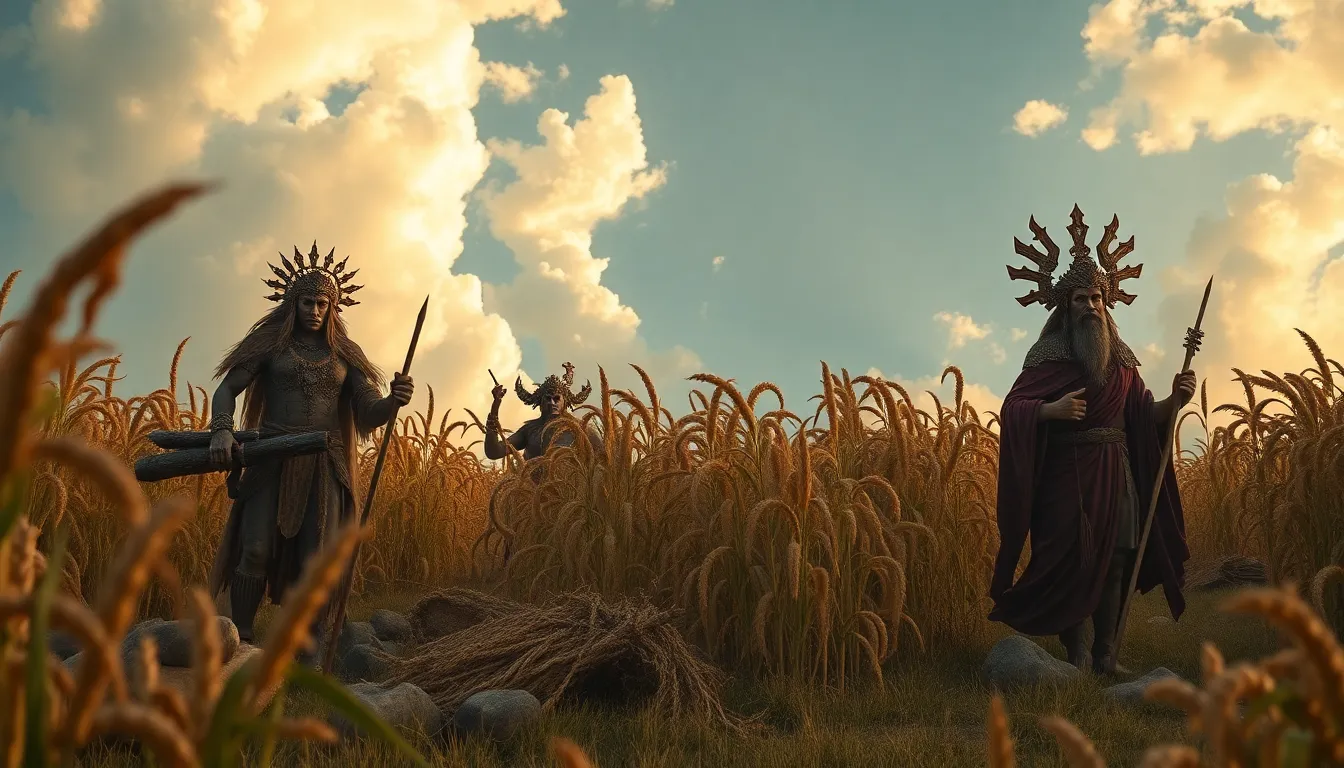Ancient Deities and Their Role in the Harvest: Myths of Abundance
I. Introduction
Throughout history, agriculture has formed the backbone of human civilization. Ancient cultures relied heavily on the success of their crops and livestock, intertwining their agricultural practices with deep-rooted beliefs and traditions. Among these beliefs, the reverence for deities associated with the harvest played a crucial role in agrarian societies. These gods and goddesses were not merely figures of worship; they were seen as vital to ensuring the fertility of the land and the abundance of food. This article explores the myths surrounding these deities and their significance in promoting prosperity and abundance in ancient cultures.
II. The Concept of Abundance in Ancient Cultures
Abundance in agrarian societies refers to the plentiful yield of crops and livestock, which was essential for survival and prosperity. This concept was significant as it influenced not only the economy but also social structures, rituals, and cultural identities. Harvest time was celebrated through various rituals and festivals, reflecting gratitude and hope for continued blessings from the deities.
- Rituals and Celebrations: Many cultures had specific festivals to celebrate the harvest, expressing gratitude and seeking favor for future yields.
- Role of Deities: Deities were believed to directly influence agricultural outcomes, and their favor was sought through offerings, prayers, and ceremonies.
III. Major Agricultural Deities Across Cultures
A. Demeter and Persephone in Greek Mythology
In Greek mythology, Demeter, the goddess of the harvest, and her daughter Persephone play a pivotal role in the cycle of life and death, symbolizing the changing seasons.
- The Story of the Seasons: Persephone’s descent into the underworld marks the onset of winter, while her return heralds spring, demonstrating the cyclical nature of agriculture.
- Festival of Thesmophoria: This festival celebrated the fertility of the earth and included rituals to honor Demeter and Persephone, emphasizing the link between women, fertility, and the harvest.
B. Ceres in Roman Religion
Ceres, the Roman equivalent of Demeter, was similarly revered as the goddess of agriculture, grain crops, and fertility.
- Influence on Agriculture and Grain: Ceres was considered essential for the growth of crops, particularly grains, which were staples of the Roman diet.
- The Significance of the Ludi Cereris Festival: This festival included games and offerings, reflecting the importance of Ceres in ensuring a fruitful harvest.
C. Osiris in Egyptian Mythology
Osiris, the Egyptian god of the underworld and agriculture, embodies the themes of death and resurrection, symbolizing the fertility of the Nile River and its life-giving waters.
- Symbolism of Resurrection and Fertility: Osiris’s death and resurrection correlate with the annual flooding of the Nile, which enriched the soil for agriculture.
- The Role of the Nile in Agricultural Cycles: The Nile was crucial for irrigation and crop growth, making Osiris a central figure in Egyptian agricultural society.
IV. Lesser-Known Harvest Deities
A. Xipe Totec in Aztec Mythology
Xipe Totec, known as the “Flayed One,” was an important deity associated with agricultural renewal and the changing of seasons in Aztec culture.
- Associations with Renewal and Agriculture: Xipe Totec represented the rebirth of nature, particularly in the springtime when crops began to grow.
- Rituals of Renewal and Sacrifice: Ceremonies included offerings and sacrifices to ensure a fruitful harvest, reflecting the deep connection between life, death, and rebirth.
B. Freyr in Norse Mythology
Freyr, a god of fertility, prosperity, and fair weather, was essential to the Norse people’s agricultural success.
- God of Fertility and Peace: Freyr was invoked for bountiful crops and peace among communities, highlighting the interconnectedness of agriculture and social harmony.
- Influence on Harvest and Prosperity: His presence in rituals ensured good weather and fruitful harvests, essential for survival in the harsh Nordic climate.
C. Haumea in Hawaiian Culture
Haumea, the Hawaiian goddess of fertility and childbirth, is deeply connected to the land and agricultural practices of the islands.
- Goddess of Fertility and the Land: Haumea is revered as the source of life and abundance, embodying the spirit of the land.
- Connection to the Cycle of Planting and Harvesting: Her worship involved rituals that honored the planting and harvesting cycles, essential for the sustenance of the community.
V. Mythical Stories Illustrating Harvest Abundance
A. The Tale of Demeter and Persephone
This myth not only explains the changing seasons but also serves as a narrative of hope and renewal, celebrating the cyclical nature of life and agriculture.
B. The Legend of the Corn Mother
A widespread story among Native American cultures, the Corn Mother symbolizes fertility and the sustenance provided by the earth, illustrating the deep respect for agricultural life.
C. The Sumerian Myth of Inanna and Enki
This myth highlights the importance of divine favor in agriculture, depicting Inanna’s journey and her acquisition of the gifts necessary for cultivating the land.
VI. Rituals and Festivals Celebrating Harvest Deities
A. Ancient Greek Thesmophoria
This festival was dedicated to Demeter and celebrated women’s roles in agriculture, emphasizing fertility and the harvest.
B. Roman Cerelia Festival
Celebrating the goddess Ceres, this festival included games and rituals to ensure agricultural bounty and community cohesion.
C. Harvest Moon Festivals in Various Cultures
Across cultures, the harvest moon signifies gratitude and celebration, marking the time for gathering crops and preparing for winter.
VII. Agricultural Innovations Inspired by Myths
Myths not only shaped cultural practices but also inspired agricultural innovations. Many societies integrated their beliefs into farming techniques, considering the favor of the gods in their strategies.
- Influence on Farming Techniques: Rituals and practices developed from myths often dictated seasonal planting and harvesting schedules.
- Role of Deities in Agricultural Advancements: Deities were believed to provide knowledge and skills necessary for improving yields, driving innovation.
- Modern Interpretations and Adaptations: Today, some agricultural practices are still influenced by ancient beliefs, showcasing the lasting impact of these myths.
VIII. The Decline of Harvest Deities in Modern Context
As societies transitioned from agrarian to industrialized economies, the role of harvest deities diminished. Urbanization and modernization led to a decline in traditional rituals and beliefs.
- Transition from Agrarian Societies to Industrialization: The shift towards mechanized farming diminished the reliance on divine favor.
- The Fading of Traditional Rituals and Beliefs: With globalization and modern science, many ancient practices and beliefs have been sidelined, although some communities still honor these traditions.
In conclusion, ancient deities related to agriculture and harvest played a critical role in shaping the cultural landscape of societies throughout history. Their stories and associated rituals highlight the profound connection between humanity and nature, the cycles of life, and the ever-present hope for abundance. While the relevance of these deities may have waned in modern times, their legacy continues to influence contemporary agricultural practices and cultural celebrations.



